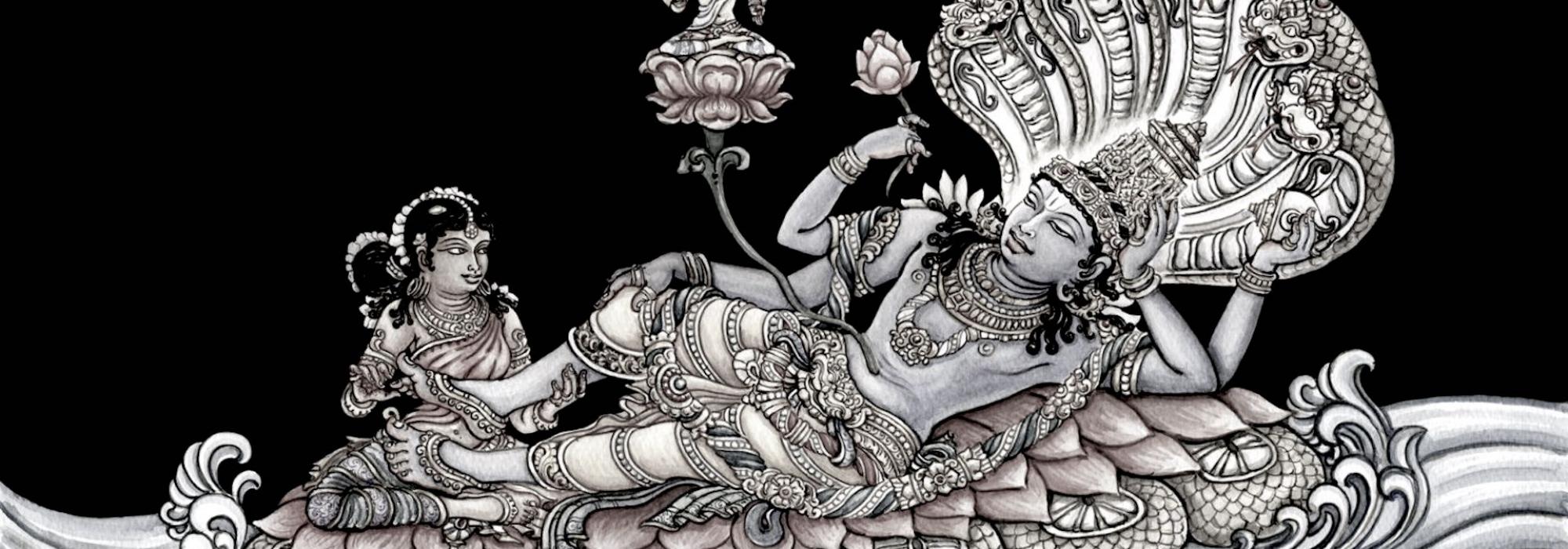The Creation Process as Described in the Vishnupurana
In the creation process described in the Vishnupurana, there is a mix of Kapila’s sāṅkhya system and some elements of Vedanta. It is difficult to harmonize the two. From an overall perspective, there exist several internal contradictions between the two. The commentary of Sridhara resolves these contradictions, brings about integrity between the premises and conclusions and shows a beautiful harmony. The Vishnupurana describes the process of Creation respectively, in the following order: avyakta (Unmanifested), mahat (Big or Great), ahaṅkāra (Ego) and sūkṣmabhūta (Subtle Bodies). Although this is not unacceptable to Vedantins, they do not agree with the proposition that the inert avyakta causes Creation. Therefore, they accept the Atman, which is an aspect of the Primordial Energy, which is also the root of the Twenty-four Elements laid down in sāṅkhya. The Vishnupurana has endorsed this Primordial Energy. It is notable that the Vishnupurana uses the Vedantic word avidyā to denote avyakta used in sāṅkhya. The Primordial Energy which is the root cause of this world is the selfsame Formless Brahma. This Brahma takes on the forms of Brahma, Vishnu and Rudra due to the interplay of the triguṇa, something that this Purana describes repeatedly. Although this Brahma is without attributes, it contains great powers which are inconceivable by the intellect just like how fire contains heat within it. Akin to the indivisibility between Energy and its Possessor, there is no inconsistency in the Advaitic philosophy expounded in this Purana. The chief stand of the Vishnupurana is that Vishnu is the most excellent manifestation among the (three) saguṇa manifestations. Therefore, Vishnu is extolled as the greatest. Because both Brahma and Rudra are also saguṇa manifestations of the Formless Brahma, these three together, that is, the Trimurtis are equal and indivisible. This is the unambiguous philosophy of this Purana. The following words clarify that Narayana is indeed Brahma:
brahmānārāyaṇākhyosau (4.1)
brahmasvarūpī bhagavān (1.4.4)
svayaṃ viśveśvaro hariḥ brahmā bhūtvā (1.2.61)
brahmarupadharaḥ śete bhagavanādi kṛt hariḥ (6.4.4)
We can also notice another specialty here. The Vishnupurana declares that in the process of Creation, Brahma transformed his body into different forms (i.e., creatures). He is described as both Creator and Creation. Besides, he is described as nimittamātramevāsau and jagacca saḥ. Thus, it is clear that the Formless Brahman is both the causal and material reason for this world. It must also be remembered that this is the axiom of Maharshi Badarayana’s Brahmasutra.
Avidyā is born when the Formless Brahman dons the manifested form of Brahma after being imbued with Rajas. This avidyā is the avyakta mentioned by sāṅkhya exponents. From this is born the principle of mahat. This mahat is also known as buddhi (intellect) and Brahma. Some Puranas refer to this principle of mahat as Brahma, who is popularly called the Creator. In the Vishnupurana, the creation of mahat is known as the First Creation. From it arises the ahamkara (Ego) from which flows the pañcatanmātra (the Five Subtle Elements: sound, touch, form, taste, and smell). From these were born the tangible physical elements which are accessible to the invisible senses. Later, immovable creations like trees and creepers were born. After this were born worms and insects. Next were born the Devatas. In the final step, humans were created (1.5.19 thru 23). Humans have an excess of the three guṇa-s namely Sattva, Rajas and Tamas. Humans have a greater share of sorrow than joy. Humans are excessively active. Because they possessed the knowledge of both the external world and inner inquiry, Brahma was delighted. Here, it is suggested that humans are more blessed than Devatas. This is because these creatures (humans) have a right to perform Karma and are therefore entitled to both Swarga (Heaven) and Moksha. Thus, the Devatas have themselves extolled the glory of Bharatavarsha as follows:
gāyanti devā: kila gītakāni
dhanyāstu te bhārata bhūmibhāge।
svargāpavargāspadamārgabhūte
bhavanti bhūya: puruṣā: suratvāt।। (2.3.24)
jānīma naitat kva vayaṃ vilene
svargaprade karmaṇi dehabandhaṃ |
prāpsyāma dhanyāḥ khalu te manuṣyāḥ
ye bhārate nendriya viprahīnā: || (2.3.26)
The following verse dripping with national love is also notable:
atra janmasahasrāṇām sahasrairapi sattama
kadācillabhate janturmānuṣyaṃ puṇyasañcayāt || (2.4.23)
The Vishnupurana describes the borders of Bharatavarsha as follows:
uttaraṃ yat samudrasya himādreścaiva dakṣiṇam |
varṣaṃ tad bhārataṃ nāma bhāratī yatra santatiḥ ||(2.3.1)
According to the Vishnupurana, we learn that Bharatavarsha comprises nine regions including the indradvīpa (literally, The Island of Indra). Of these, the names of only eight islands and mentioned and the ninth is left unnamed. It simply says, ayaṃ tu namasteṣām (2.3.7). Commentators have declared that here, the word ayaṃ stands for Bharatavarsha. The Varahapurana includes Bharatavarsha along with indradvīpa. Thus, such commentators are reliable. Bharatavarsha is part of the bharatakhaṇḍa. In this context, we can recall that we invoke the name bharatakhaṇḍa as part of the Sankalpa process. However, it is very tough to locate the exact boundaries for both bharatakhaṇḍa and Bharatavarsha. It is mentioned that the kirāta-s reside in the eastern part of the land of Bharata, and that yavana-s reside in its western part. In the middle region reside the people belonging to the Four Varnas: Brahmana, Kshatriya, Vaishya and Shudra. The rules and prohibitions prescribed in the Dharmasastras are applicable to these people of the Four Varnas. Therefore, this land is the karmabhūmi. All other countries (desha-s) are bhogabhūmi, or land of pleasure and enjoyment (atonyā bhogabhūmayaḥ). The rules and prohibitions of the Dharmasastras do not apply to them. However, even the people of those lands worship the Bhagavan in their own fashion. Thus, it is suggested that even such people attain the Exalted State in an indirect manner.
There is another noteworthy point in all this. It has been mentioned that trees and creepers were born after the Senses came into play. From this, it is implied that even trees and creepers have sense organs. The Mahabharata phrase antaḥsaṃjñayabhavantyete bolsters this opinion.
To be continued














































